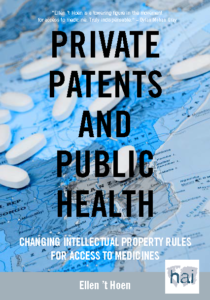 The following is an excerpt from the introduction to Private Patents and Public Health, by Ellen ‘t Hoen. The full book is available online under a Creative Commons License here.
The following is an excerpt from the introduction to Private Patents and Public Health, by Ellen ‘t Hoen. The full book is available online under a Creative Commons License here.
Millions of people around the world do not have access to the medicines they need to treat disease or alleviate suffering. Strict patent regimes interfere with widespread access to medicines by creating monopolies that maintain medicines prices well beyond the reach of those who need them.
The magnitude of the AIDS crisis in the late nineties brought this to the public’s attention when millions of people in developing countries died from an illness for which medicines existed, but were not available or affordable. Faced with an unprecedented health crisis—8,000 people dying daily—the public health community launched an unprecedented global effort that eventually resulted in the large-scale availability of quality generic HIV medicines and a steady scale-up in access to those medicines. This has allowed nearly 13 million people to lead longer, healthier lives. However, trends in international intellectual property law could impact many of the policy tools used to scale up HIV treatment.
Developments in global health and specifically access to medicines policies are now at an important juncture. Impressive progress has been made in access to medicines for HIV and many lessons can be learned from that experience. But it is important to examine whether those lessons can be applied for other diseases. Today’s pharmaceutical patent regime affects almost all medicines developed since 1995 in most countries. The high prices of new medicines, such as for cancer, tuberculosis and hepatitis C, cause huge access challenges globally, in both developed and developing countries. These new global challenges pose the question of whether the public health approaches to medicines patents developed in response to the HIV/AIDS crisis are exclusive to HIV or whether they can be applied more broadly.
This book provides a history of the parallel developments in global public health and international patent laws: detailing the current situation, how we got here, and how we can move forward to best protect the future of medical innovation as well as the lives that will depend on it.
Click here for the full book, available online under a Creative Commons License (CC-BY-NC-SA)




